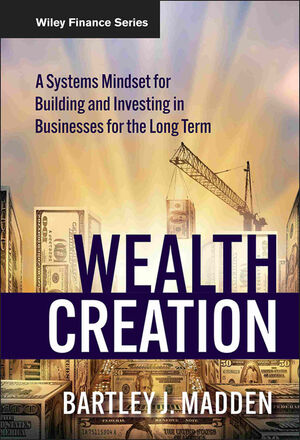Wealth Creation: A Systems Mindset for Building and Investing in Businesses for the Long TermISBN: 978-0-470-48868-3
Hardcover
208 pages
March 2010
 |
||||||
Preface xi
Acknowledgments xvii
CHAPTER 1 A Systems Mindset 1
How We Know What We Think We Know 2
The PAK (Perceiving-Acting-Knowing) Loop 3
Purposes 3
Perceptions 4
Cause and Effect 6
Actions and Consequences 7
Feedback 8
Knowledge Base 9
Examples of Systems Thinking and Problem Solving 10
High-Reliability Organizations 10
Eli Goldratt, Business Theorist 12
Colonel John Boyd, Military Theorist 14
Correlation, Causality, and Control Systems 15
Summary of Key Ideas 17
CHAPTER 2 The Wealth-Creation System 19
The Perception of Free-Market Capitalism 20
The Housing and Credit Crisis of 2008–2009 21
Government Regulation and Unknown Risks 25
The Standard of Living 28
Summary of Key Ideas 33
CHAPTER 3 The Ideal Free-Market System 35
Components of a Free-Market System 36
Consumer Wealth, Producer Wealth, and Competition 39
Efficiently Providing What Consumers Want 41
Summary of Key Ideas 43
CHAPTER 4 The Competitive Life-Cycle View of the Firm 45
Competitive Life-Cycle Framework 45
Firms’ Competitive Life Cycles and Dynamism 47
Company Examples 51
Eastman Kodak 53
IBM 55
Digital Equipment 58
Apple 59
Bethlehem Steel 62
Nucor 63
Kmart 67
Medtronic 69
Walgreen Company 71
Donaldson Company 73
Life-Cycle Observations 75
Summary of Key Ideas 76
CHAPTER 5 The Life-Cycle Valuation Model as a Total System 79
Efficient Markets versus Behavioral Finance 80
Valuation Model Principles 81
Measurement Units 86
Forward-Looking, Market-Derived Discount Rates 89
Problems with CAPM Cost of Capital 91
Improving the Valuation Process 93
Investor Expectations: The Wal-Mart Example 96
Critical Accounting Issues 99
Reply to Critics 102
Summary of Key Ideas 104
CHAPTER 6 Business Firms as Lean, Value-Added Systems 107
Lean Thinking and PAK Loop Components 108
Knowledge Base 108
Purposes 111
Perceptions 113
Cause and Effect 114
Actions and Consequences 115
Feedback 116
A Lean Transformation Example: Danaher 118
Summary of Key Ideas 121
CHAPTER 7 Corporate Governance 123
A Systems View for Corporate Governance 123
Corporate Governance Needs Repair 124
A Standard of Performance for Boards 127
A Successful Cultural Transformation Example: Eisai Co., Ltd. 128
Shareholder Value Review 130
Valuation Model Selection 133
Value-Relevant Track Records 135
Business Unit Analyses 137
Reply to SVR Objections 138
SVR as an Evolutionary Process 140
Summary of Key Ideas 141
CHAPTER 8 Concluding Thoughts 143
Benefits for Public Policy Makers 144
Benefits for Business Managers 146
Benefits for Investors 148
Notes 153
References 159
About the Author 167
Index 169



